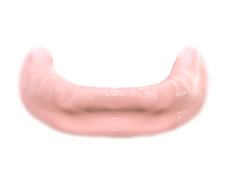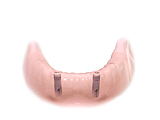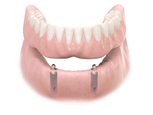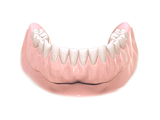Replacing all teeth with dental implants
If you are missing all of your teeth in the upper or lower jaw, dental implants are the best solution for you. Or if you have dentures right now and they keep falling out, dental implants will be the best solution for you. Talk to your oral surgeon about your implant options. You can either have a removable prosthesis like your dentures that are anchored to your jaws with two or more implants. The denture will remain secured to your mouth and will not move when you talk or eat. However, you can easily remove it when you need to. Another option is to choose a full bridge that is attached to several dental implants. This full bridge will remain fixed in your mouth and does not need to be removed.
Step by Step
Step 1
If you have lost all of your teeth in one or both jaws, you may not be happy with your existing or a conventional denture. The conventional denture moves around when you talk or eat. The implant overdenture is secured to your jaw bone by connecting it to two or more implants.

Step 2
Two or more dental implants are inserted into your jaw bone. They will provide a secure foundation to attach to your prosthesis or denture.

Step 3
The overdenture is connected to ball abutments on the implant such as those in the picture below.

Step 4
The overdenture is now in place, well secured to your jawbone via the two dental implants. It looks and functions like natural teeth. You don’t have to worry about the prosthesis falling out, whether you are laughing or eating. People are much happier with a dental implant-supported prosthesis.

Treatment Overview
Diagnosis and A thorough examination
The first step in dental implant treatment is a discussion with your oral surgeon. Dr. Aidelbaum and Dr. Chen will determine whether implants are the right solution for you by taking X-Ray images and computer tomography and conducting a thorough clinical examination. We have the special three-dimensional imaging technology to evaluate the quantity of your bone and the ideal placement of your future dental implant. They will speak to your restorative dentist to formulate the ideal plan for your clinical situation.
Implant Insertion
The implant is inserted under local anesthesia, intravenous sedation or general anesthesia. Depending on your clinical situation, your oral surgeon may give you two options with respect to the placement of your dental implant. The first option is a one-step procedure where the dental implant is inserted a temporary abutment is immediately attached. The second option is a two-step procedure where the dental implant is inserted and then covered by gum during the healing process. The abutment is installed at a later date.
In either case, you may have a temporary tooth or prosthesis put in place during the healing period. A healing period of three to four months is recommended for the lower jaw and six to eight months for the upper jaw, depending on your clinical situation. It is also possible to load the implant immediately or attach the temporary restoration to the implant immediately if your bone condition is optimal.
Attaching the abutments
For the one-step procedure, the temporary abutment is removed after the implant has healed with the bone tissue. This abutment is replaced with a permanent abutment for future restoration. The second part of the two-step procedure involves a small incision to open the gum and place the permanent abutment onto the implant. This is a fairly simple and quick procedure.
Producing the teeth
After the abutment is in place, a new impression or mold is made of both jaws and your occlusion or your bite is recorded. A dental technician will then use the impression to carefully create your new crown, bridge, or denture. Special attention is given to ensure the colour and shape of your new teeth will look like your natural teeth.
Fitting and re-examination
When the denture is ready, they are simply attached to the dental implants. They will function just like your natural teeth. Just like natural teeth, they will require regular check-ups and conscientious oral hygiene. There will usually be a few follow-up visits to make sure you are absolutely satisfied with your new teeth.

